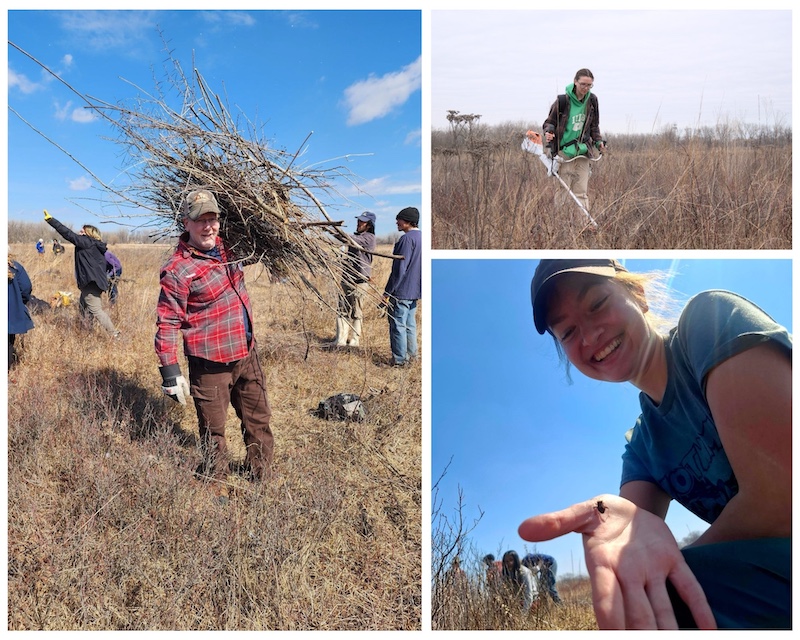
On a foggy morning, volunteers arrived at the worksite: a sea of dense brush, overgrown in the absence of fire. The group has been meeting weekly to knock back brush from the highest quality parts of the prairie. Photo by Dave Lynn.



On a foggy morning, volunteers arrived at the worksite: a sea of dense brush, overgrown in the absence of fire. The group has been meeting weekly to knock back brush from the highest quality parts of the prairie. Photo by Dave Lynn.
According to Illinois Nature Preserves Commission Natural Areas Preservation Specialist Kim Roman, the story of reinvigorated stewardship at Markham Prairie is “A little bright spot in a world dominated by bad news.” How did that happen?
On March 8, 2025, Gensburg-Markham Prairie Nature Preserve attracted the biggest Friends of Illinois Nature Preserves (Friends) kickoff event to date. A triumphant team of 67 volunteers joined together to revive a legacy of stewardship.

Markham Prairie is owned and managed by Northeastern Illinois University (NEIU) and The Nature Conservancy. The heart of the site, owned by NEIU, was once considered one of the finest examples of tallgrass prairie in the world and was long-supported by a close-knit group of staff and volunteer stewards headed first by Dr. Robert Betz, a visionary in prairie restoration. But over the years, particularly after Betz’ successor Dr. Ron Panzer was no longer able to care for the site, volunteer involvement dwindled, and with it, the integrity of the prairie.
When Martha Lopez-Salazar of NEIU was hired as land manager for the site in 2022, she had a vision for increased community connections. She knew, humbly, that funding can ebb and flow, but volunteers who care can be resilient. She also recognized the need: in a high stakes situation where she alone was responsible for managing 181 acres, the site she cared about so deeply was at risk.
Lopez-Salazar reached out to Kim Roman, who connected her with Friends field rep Jo Sabath. After Sabath shared the news with volunteers from other Friends-supported communities, some of them joined together to form a collaborative planning group. Some folks coordinated on an outreach strategy. Artists produced flyers and social media campaigns and collaborated on press releases. Some focused on day-of logistics. All worked together on language that would inspire and activate new grassroots leadership for the community’s future. People cared — paralegals, factory workers, teachers, conservation professionals. They were Friends – to each other and to this prairie.
Many of these people were young and relatively new. But as volunteer Dave Lynn put it: “What’s important to understand about the way Markham came together is that this is something that anybody is capable of helping to organize. You need to be willing to learn, collaborate and work with others. And you need to want to get stuff done.”
Many people assume that if you’re not getting paid to do something, it either must not be that important, or you’re not qualified to do it. This attitude risks becoming a self-fulfilling prophecy. The work being done by Friends volunteer stewards presents a model that gets results. Working closely with Martha Lopez-Salazarand other conservation experts to establish ecological priorities and consult on best stewardship strategies, the group is also learning from more than 30 years of management data, shared via flash drive.
Noah Hornak, a native seed nursery technician at the Chicago Botanic Garden who also volunteers at various sites, saw this opportunity as a chance to broaden his impact. “I really like the physical and the ecological aspect of the work that we do,” Hornak said. “But I realize I can also play a role in facilitating the deeper involvement of all the volunteers who show up. We try to be conscious of removing barriers to new leadership and initiative.”
Markham’s highest quality remnants have suffered increasingly from encroachment of overabundant brush, a result of limiting the amount of fire to protect rare animals (mostly invertebrates). When this prairie was vast, adequate refuges existed. But with fragmentation, we have to plan for them. Maintaining the balance is not easy. Too much fire is a threat to some animals. Too little is a threat to the grasses and wildflowers that most of these animals depend on. When shrubs kill off the grassland species, stewards have to step in to restore the balance.
The Markham stewards have already made a big dent in clearing dense brush off some of the highest quality parts of the prairie. And this is just the start. Lynn added, “As humans, we have the capability to do just about anything. Usually, when we hear that in the context of the environment, it’s a negative. We think about how many species human activity is forcing into extinction. But we can do the opposite, too. We can bring species and ecosystems back from the brink. We can perform acts of resurrection and make a global difference. There’s an urgency to it, but it also feels like a profound honor — we get to do this. We get to take care of the prairie. And by doing it, we get to take care of each other.”
The author benefited greatly from good edits and proofing by Noah Hornak, Dave Lynn, Stephen Packard and Jo Sabath.
Rebeccah Hartz is a passionate volunteer in ecological restoration, and the assistant director of Friends of Illinois Nature Preserves.
Submit a question for the author